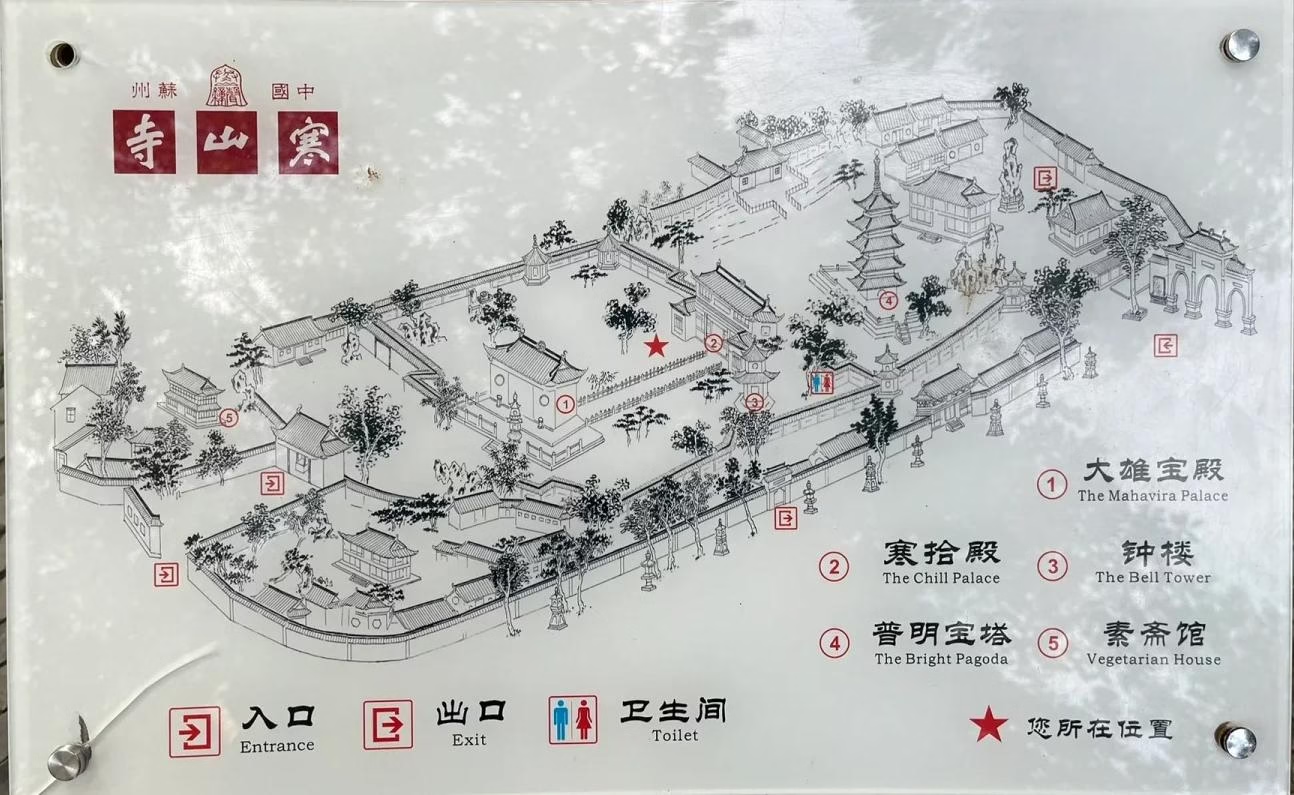Suzhou Hanshan Temple (寒山寺), originally named “Miaoli Puming Pagoda Monastery,” was established during the Tianjian era of the Southern Dynasty Xiao Liang period (502-519 AD). Occupying an area of approximately 13,000 square meters, with a construction area of over 3,400 square meters, the temple gained widespread fame through the renowned Tang Dynasty poet Zhang Ji’s verse in “Night Mooring at Maple Bridge,” which includes the line, “Outside Suzhou’s Gu Su City, Hanshan Temple’s bells reach the guest boat in the middle of the night.”
Belonging to the Linji sect of the Zen school, Hanshan Temple was founded by two eminent monks, Hanshan and Shiqian, during the Tang Dynasty’s Zhenguan period. Legend has it that during Emperor Taizong’s Zhenguan era, two young men named Hanshan and Shide were close friends from childhood. When Hanshan’s parents arranged a marriage for him with a girl from Qing Shan Bay, it turned out that she was already in love with Shide. Upon learning the truth, Hanshan decided to sacrifice his own happiness for Shide and left his hometown to become a monk in Suzhou. Later, Shide also discovered the truth and went to Suzhou to find Hanshan, eventually both taking refuge in Buddhism together.
Table of Contents
- Basic Information
- Location and Transportation
- Map of Hanshan Temple
- Highlights of Suzhou Hanshan Temple
- Vlog about Hanshan Temple
- A Brief History of Hanshan Temple
- Useful Information Summarized from Reviews
- Other Temples in Suzhou
Basic Information
| website | https://www.hanshansi.org/ |
| Estimated Length of Tour | About 2 hours |
| Ticket Price | 20 RMB |
| Opening Hours | 7.30 – 16.30; Last admission: 15.30 |
| Telephon Number | 0086-021-59626211 |
Location and Transportation
Suzhou Hanshan Temple is in the city of Suzhou, which is located in the southeastern Jiangsu province of China. The exact location of Hanshan Temple is about 5 kilometers west of the Suzhou city center, in the Fengqiao area, near the ancient Grand Canal. To get to the temple, you can choose the following ways:
Bus: Take bus 9002, 24, or Tourist Line 1 and get off at Hanshan Temple Stop (寒山寺站).
Metro: The nearest metro station to Hanshan Temple is Binhe Road (滨河路) on line 1. After getting out of the station from Exit 3, you can walk or take a shared bike to cover the remaning 1.6 kilometers.
Map of Hanshan Temple

Highlights of Suzhou Hanshan Temple
Puming Pagoda

The Puming Pagoda serves as a symbolic structure of Hanshan Temple. The pagoda underwent several reconstructions and faced three instances of destruction. The current one was rebuilt in 1997, designed as a wooden-structured tower imitating Tang Dynasty architecture. It stands four-sided and five-storied, with a total height of 42.2 meters. The architectural blueprint drew inspiration from Tang-style pagodas depicted in Dunhuang murals while incorporating elements from buildings such as the Southern Zen Hall and Buddha Light Hall of Mount Wutai in Shanxi, as well as Yangzhou’s Pingshan Hall.
Poetic and Historical Significance

Suzhou Hanshan Temple holds profound poetic and historical significance in Chinese culture. Immortalized in Zhang Ji’s Tang Dynasty poem “A Night Mooring near Maple Bridge,” it became an emblem of solitude and introspection. The temple’s connection to the legendary monk-poet Hanshan amplifies its spiritual aura. As a sanctuary for travelers along the ancient Grand Canal, it witnessed centuries of history, attracting scholars, artists, and devotees seeking inspiration. Its iconic Puming Pagoda, standing tall for generations, symbolizes China’s enduring architectural brilliance.
Fengqiao Ancient Town

Situated at the intersection of the Grand Canal, ancient post roads, and the Feng River, Fengqiao Ancient Town features two main streets, Fengqiao Street and Hanshan Temple Lane, developed along the river, showcasing a distinctive water town charm. The town thrived during the Song and Yuan dynasties and reached unprecedented prosperity during the Ming and Qing periods, becoming the largest grain distribution center in the country.
Bell Ringing Ceremony

Hanshan Temple boasts the “Number One Buddhist Bell in the World,” a replica of an ancient bronze bell in Tang style. Weighing 108 tons, the bell stands at a height of 8.588 meters, with a maximum diameter of 5.188 meters at the bottom skirt. The bell surface is inscribed with the entire text of the “Lotus Sutra of the Wonderful Dharma,” totaling 69,800 characters. Every year on December 31st, the temple holds a bell-ringing ceremony, striking the bell 108 times. Each strike represents a vexation, and as the bell tolls, the troubles of the past year are said to be carried away by the wind.
Main Hall

The main hall of Hanshan Temple, with a width of five rooms and a depth of four rooms, stands at a height of 12.5 meters. In front of the main hall, a copper tripod on a furnace platform bears the inscription “一本正经 (A Genuine Scripture)” on its front and “百炼成钢 (Tempered into steel through a hundred trials)” on its back. This area encapsulates a religious legend: during a dispute between Chinese monks and Taoists, they tested whose scripture could withstand a fire. The Buddhists placed the Diamond Sutra into the copper tripod and it remained unscathed. To commemorate this event, the inscription was engraved on the tripod.
Vlog about Hanshan Temple
A Brief History of Hanshan Temple
Early History: During the Southern Dynasty, around the Liang Dynasty, Master Puming passed through Suzhou on his travels, and after his death, he was buried near the temple site, where a stupa was erected in his memory. In the Tang Dynasty, the famous monk Hanshan (Cold Mountain), known for his poetry, resided at the temple, which was later named Hanshan Temple. The temple’s fame was greatly enhanced by the poet Zhang Ji, who wrote the famous poem “Fengqiao Night Mooring” in 756, immortalizing the temple’s bell and the surrounding landscape.
Song Dynasty: The temple continued to flourish, and during the Northern Song period, it was rebuilt and renamed as “Puming Chan Yuan”. The temple suffered during the invasion of the Jin army in 1130, with many buildings destroyed, but it was restored by the monk Fa Qian, who worked tirelessly to rebuild it over twelve years.
Ming and Qing Dynasties: The Ming Dynasty saw the temple restored again, notably under the leadership of monks such as Chang Chong and Shen Gu Chang, who built new structures and added to the temple’s charm. The temple was also a cultural hub for poets and artists. During the Qing Dynasty, it underwent multiple reconstructions due to fires and other disasters. In 1774, the temple was reconstructed by the monk Xuan Neng, adding a new grand hall and other significant structures.
Modern Times: After the fall of the Qing Dynasty and the turmoil of the Republic of China, Hanshan Temple faced many challenges, including being used as a warehouse during the Japanese occupation. In the 1950s, the temple began to recover with the help of local authorities and monks, who ensured its preservation. In the 1970s, after the Cultural Revolution, efforts to restore the temple gained momentum, and by the 1980s, it was once again a vibrant cultural and religious site.
Useful Information Summarized from Reviews
Bell Ringing for Blessings (¥5 for 3 times): The Bell Tower offers a unique experience where you can ring the bell for blessings. This is a paid activity, and you can participate by paying ¥5 for three attempts.
Feeding the Koi Fish (¥10 for fish food): Purchase fish food for ¥10 and enjoy the chance to feed the large Koi up close, hoping to share in their good luck.
Entering the Temple: When entering the temple, be mindful not to step on the threshold. Follow the flow of people and step over it to show respect.
Visit the Vegetarian Noodle House Inside the Temple: Inside Hanshan Temple, there is a vegetarian noodle house located near the entrance. It offers delicious and reasonably priced meals. It’s worth trying, but be aware that there might be queues, especially during lunchtime.








I thought Hanshan Temple would be a traditional temple, but it turned out to be a combination of a garden and a temple. The rose-colored walls along with the little bridges and flowing water create a truly elegant atmosphere.